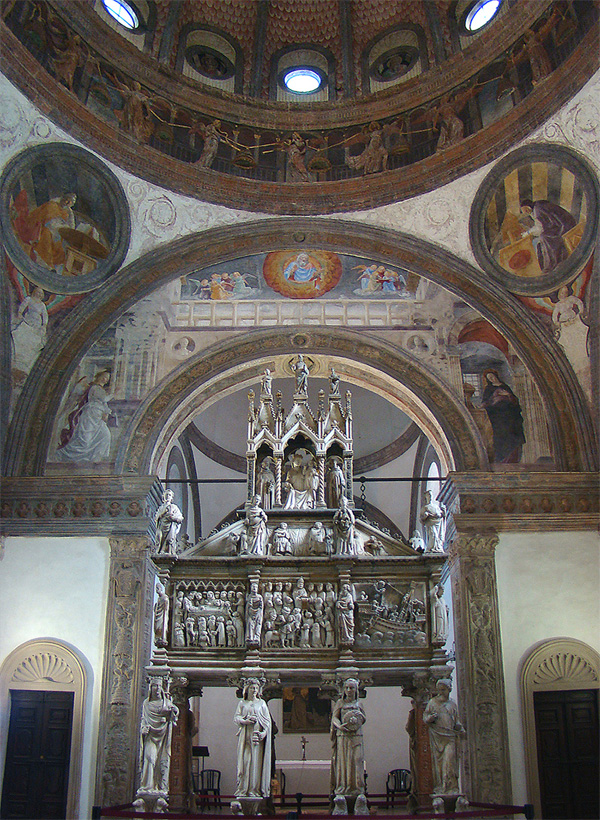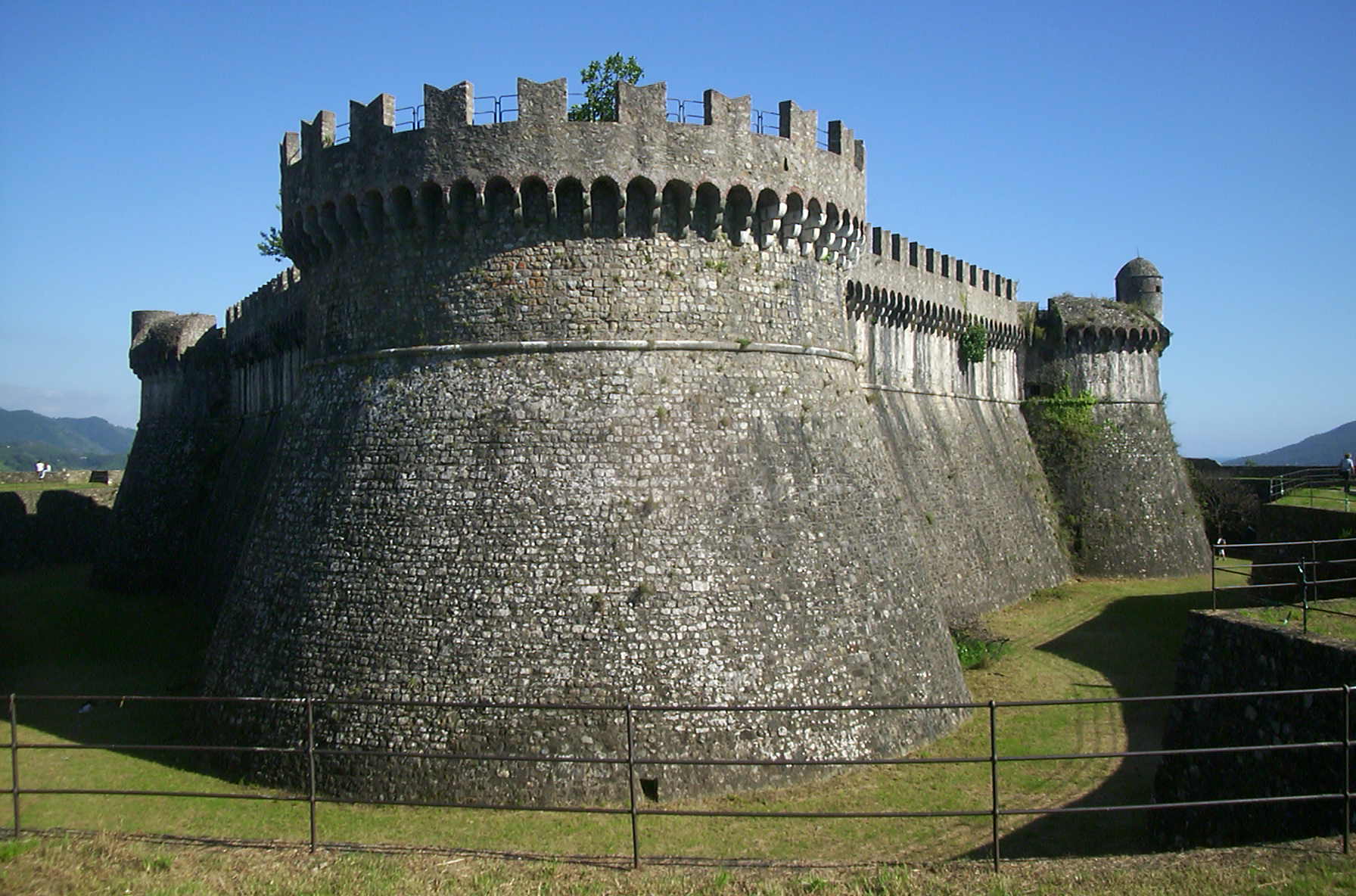|
Giovanni Di Balduccio
Giovanni di Balduccio (c. 1290 – after 1339) was an Italian sculptor of the Medieval period. Life The artist was born in Pisa, and likely did not train directly with the famous Pisan sculptor Andrea Pisano. He travelled to Milan to help sculpt the arc of St. Peter Martyr now in the Portinari Chapel, in the Basilica of Sant'Eustorgio, work signed in 1339. He also worked on the portal of the church of the Brera in Milan. He also worked in San Casciano in Val di Pesa and in the monument of Guarniero in Sarzana Sarzana (, ; lij, Sarzann-a) is a town, ''comune'' (municipality) and former short-lived Catholic bishopric in the Province of La Spezia, Liguria, Italy. It is east of Spezia, on the railway to Pisa, at the point where the railway to Parma diver .... His style is known from four signed works. These formed the basis for a reconstruction of his oeuvre.G. Kreytenberg. "Giovanni di Balduccio." Grove Art Online. Oxford Art Online. Oxford University Press. Web. 3 October ... [...More Info...] [...Related Items...] OR: [Wikipedia] [Google] [Baidu] |
Medieval
In the history of Europe, the Middle Ages or medieval period lasted approximately from the late 5th to the late 15th centuries, similar to the Post-classical, post-classical period of World history (field), global history. It began with the fall of the Western Roman Empire and transitioned into the Renaissance and the Age of Discovery. The Middle Ages is the middle period of the three traditional divisions of Western history: classical antiquity, the medieval period, and the modern history, modern period. The medieval period is itself subdivided into the Early Middle Ages, Early, High Middle Ages, High, and Late Middle Ages. Population decline, counterurbanisation, the collapse of centralized authority, invasions, and mass migrations of tribes, which had begun in late antiquity, continued into the Early Middle Ages. The large-scale movements of the Migration Period, including various Germanic peoples, formed new kingdoms in what remained of the Western Roman Empire. In the ... [...More Info...] [...Related Items...] OR: [Wikipedia] [Google] [Baidu] |
Pisa
Pisa ( , or ) is a city and ''comune'' in Tuscany, central Italy, straddling the Arno just before it empties into the Ligurian Sea. It is the capital city of the Province of Pisa. Although Pisa is known worldwide for its leaning tower, the city contains more than twenty other historic churches, several medieval palaces, and bridges across the Arno. Much of the city's architecture was financed from its history as one of the Italian maritime republics. The city is also home to the University of Pisa, which has a history going back to the 12th century, the Scuola Normale Superiore di Pisa, founded by Napoleon in 1810, and its offshoot, the Sant'Anna School of Advanced Studies.Scuola Superiore Sant'Anna di Pisa Information statistics History ...
|
Andrea Pisano
Andrea Pisano (Pontedera 12901348 Orvieto) also known as Andrea da Pontedera, was an Italian sculptor and architect. Biography Pisano first learned the trade of a goldsmith. Pisano then became a pupil of Mino di Giovanni, about 1300, and worked with him on the sculpture for S. Maria della Spina at Pisa and elsewhere. He made his chief works in Florence, and the formation of his mature style was due rather to Giotto di Bondone than to his earlier master. Of the three world-famed bronze doors of the Baptistery in Florence, the earliest one on the south side was Pisano's work; he started it in 1330 and finished it in 1336. It consists of a number of small quatrefoil panels, the lower eight containing single figures of the Virtues, and the rest scenes from the life of John the Baptist. Andrea Pisano, while living in Florence, also produced many important works of marble sculpture, all of which strongly show Giotto's influence. In 1340 he succeeded Giotto as Master of the Works of ... [...More Info...] [...Related Items...] OR: [Wikipedia] [Google] [Baidu] |
Milan
Milan ( , , Lombard: ; it, Milano ) is a city in northern Italy, capital of Lombardy, and the second-most populous city proper in Italy after Rome. The city proper has a population of about 1.4 million, while its metropolitan city has 3.26 million inhabitants. Its continuously built-up urban area (whose outer suburbs extend well beyond the boundaries of the administrative metropolitan city and even stretch into the nearby country of Switzerland) is the fourth largest in the EU with 5.27 million inhabitants. According to national sources, the population within the wider Milan metropolitan area (also known as Greater Milan), is estimated between 8.2 million and 12.5 million making it by far the largest metropolitan area in Italy and one of the largest in the EU.* * * * Milan is considered a leading alpha global city, with strengths in the fields of art, chemicals, commerce, design, education, entertainment, fashion, finance, healthcar ... [...More Info...] [...Related Items...] OR: [Wikipedia] [Google] [Baidu] |
Portinari Chapel
The Portinari Chapel (Italian: ''Cappella Portinari'') is a Renaissance chapel at the Basilica of Sant'Eustorgio, Milan, northern Italy. Commenced in 1460 and completed in 1468, it was commissioned by Pigello Portinari as a private sepulchre and to house a silver shrine given by Archbishop Giovanni Visconti in 1340 containing the relic head of St. Peter of Verona, to whom the chapel is consecrated.‘Cappella Portinari’ Basilica di Sant’Eustorgio (official site). The architect is unknown, the traditional attribution to Michelozzo having been succeeded with equal uncertainty by attributions to either or |
Basilica Of Sant'Eustorgio
The Basilica of Sant'Eustorgio is a church in Milan in northern Italy, which is in the Basilicas Park city park. It was for many years an important stop for pilgrims on their journey to Rome or to the Holy Land, because it was said to contain the tomb of the Three Magi or ''Three Kings''. Probably founded in the 4th century, its name refers to Eustorgius I, the bishop of Milan to whom is attributed the translation of the supposed relics of the Magi to the city from Constantinople in 344. In 1764, when an ancient pillar was removed, a Christian burial was discovered, housing coins of emperor Constans, the son of Constantine the Great. The church was later rebuilt in Romanesque style. In the 12th century, when Milan was sacked by Frederick Barbarossa, the relics of the Magi were appropriated and subsequently taken to Cologne. It was only in 1903/4 that fragments of the bones and garments were sent back to Sant'Eustorgio's. Nowadays they are in the Three Kings altar nearby the e ... [...More Info...] [...Related Items...] OR: [Wikipedia] [Google] [Baidu] |
San Casciano In Val Di Pesa
San Casciano in Val di Pesa is a ''comune'' (municipality) in the Metropolitan City of Florence in the Italian region Tuscany, located about southwest of Florence. San Casciano in Val di Pesa borders the following municipalities; Greve in Chianti, Impruneta, Montespertoli, Scandicci and Tavarnelle Val di Pesa. History San Casciano’s territory was inhabited since Etruscan times, as evidenced by archaeological findings in Montefiridolfi (The Bowman’s Grave) and Valigondoli (Poggio La Croce’s excavations). In Roman times San Casciano was a post-stage ('' mansio'') posted at the tenth mile from Florentia. The toponym "Decimo" (i.e. tenth) is still attached to the Pieve di Santa Cecilia a Decimo (a parish church near San Casciano which was mentioned in 1043 in a document and commemorates a milestone (decimum lapidem) on an important Roman road (probably that linking Florentia and Sena Julia). Archaeological findings and toponymic evidence are clear evidence of the town’s ... [...More Info...] [...Related Items...] OR: [Wikipedia] [Google] [Baidu] |
Sarzana
Sarzana (, ; lij, Sarzann-a) is a town, ''comune'' (municipality) and former short-lived Catholic bishopric in the Province of La Spezia, Liguria, Italy. It is east of Spezia, on the railway to Pisa, at the point where the railway to Parma diverges to the north. In 2010, it had a population of 21,978. History The position of Sarzana, at the entrance to the valley of the Magra (ancient ''Macra''), the boundary between Etruria and Liguria in Roman times, gave it military importance in the Middle Ages. The first mention of the city is found in 983 in a diploma of Otto I; in 1202 the episcopal see was transferred from the ancient Luni, southeast, to Sarzana. Sarzana, owing to its position, changed masters more than once, belonging first to Pisa, then to Florence, then to the Banco di S. Giorgio of Genoa and from 1572 to dogal Genoa itself. These changes left in Sarzana a conspicuous fortress, which remains a focus of attraction for people interested in military history and spe ... [...More Info...] [...Related Items...] OR: [Wikipedia] [Google] [Baidu] |
1290 Births
1 (one, unit, unity) is a number representing a single or the only entity. 1 is also a numerical digit and represents a single unit of counting or measurement. For example, a line segment of ''unit length'' is a line segment of length 1. In conventions of sign where zero is considered neither positive nor negative, 1 is the first and smallest positive integer. It is also sometimes considered the first of the infinite sequence of natural numbers, followed by 2, although by other definitions 1 is the second natural number, following 0. The fundamental mathematical property of 1 is to be a multiplicative identity, meaning that any number multiplied by 1 equals the same number. Most if not all properties of 1 can be deduced from this. In advanced mathematics, a multiplicative identity is often denoted 1, even if it is not a number. 1 is by convention not considered a prime number; this was not universally accepted until the mid-20th century. Additionally, 1 is the ... [...More Info...] [...Related Items...] OR: [Wikipedia] [Google] [Baidu] |
14th-century Deaths
As a means of recording the passage of time, the 14th century was a century lasting from 1 January 1301 ( MCCCI), to 31 December 1400 ( MCD). It is estimated that the century witnessed the death of more than 45 million lives from political and natural disasters in both Europe and the Mongol Empire. West Africa experienced economic growth and prosperity. In Europe, the Black Death claimed 25 million lives wiping out one third of the European population while the Kingdom of England and the Kingdom of France fought in the protracted Hundred Years' War after the death of Charles IV, King of France led to a claim to the French throne by Edward III, King of England. This period is considered the height of chivalry and marks the beginning of strong separate identities for both England and France as well as the foundation of the Italian Renaissance and Ottoman Empire. In Asia, Tamerlane (Timur), established the Timurid Empire, history's third largest empire to have been ever establ ... [...More Info...] [...Related Items...] OR: [Wikipedia] [Google] [Baidu] |







